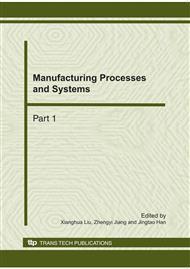[1]
C.S. Cho, B.M. Chung and M.J. Park: Development of real-time vision-based fabric inspection system, IEEE Transactions on Industrial Electronics, pp.1073-1079 (2005).
DOI: 10.1109/tie.2005.851648
Google Scholar
[2]
Ajay Kumar: Computer-Vision-Based Fabric Defect Detection: A Survey, IEEE Transactions on Industrial Electionics, pp.348-363 (2008).
DOI: 10.1109/tie.1930.896476
Google Scholar
[3]
Jasper, W.J., Gamier, S.J., Potlapalli, H.: Texture characterization and defect detection using adaptive wavelets. Optical Eng. 35(11), pp.3140-3149(1996).
DOI: 10.1117/1.601054
Google Scholar
[4]
Ajay Kumar, K.H. Pang: Defect Detection in Textured Materials Using Gabor Filters. IEEE Transactions on industry applications. Vol. 38(2). 425-440 (2002).
DOI: 10.1109/28.993164
Google Scholar
[5]
Ma Y.D., Li L., Wang Y.F., et al: Pulse-Coupled Neural Network's Principles and Applications. Beijing: Science Press, (2006).
Google Scholar
[6]
Eckhorn R, Reitboeck H J, Arndt M, et al: Feature Linking via Synchronization among Distributed Assemblies : Simulation of Results from Cat Cortex. Neural Computation, 2(3): 293-307 (1990).
DOI: 10.1162/neco.1990.2.3.293
Google Scholar
[7]
Johnson, J.L., Padgett, M. L: PCNN Models and Applications. IEEE Trans. Neural Networks 10(3), 480-498(1999).
DOI: 10.1109/72.761706
Google Scholar
[8]
Duan L. J, Lin Z. Q: A method of human skin region detection based on PCNN. Lecture Notes in Computer Science. pp.486-493 (2009).
DOI: 10.1007/978-3-642-01513-7_53
Google Scholar
[9]
Robert D Stewart, Iris Fermin, Manfred Opper: Region Growing With Pulse-coupled Neural Networks: an alternative to seeded region growing. IEEE Trans. On Neural Network, 13(6): 1557-1562 (2002).
DOI: 10.1109/tnn.2002.804229
Google Scholar
[10]
Liu, J.Z., Li, W. Q: The automatic thresholding of gray-level pictures via two-dimensional Otsu method. Acta Automat. Sinica 19(1), 101-105 (1993).
Google Scholar


